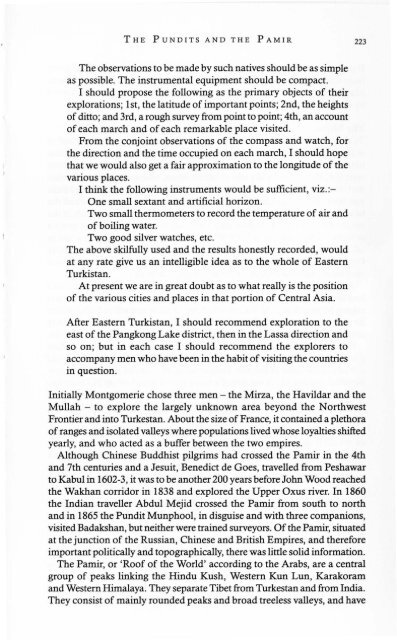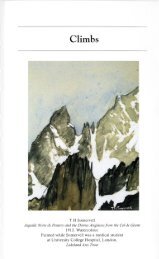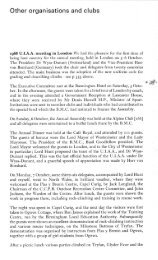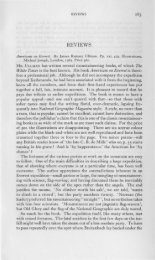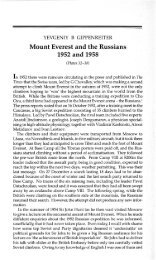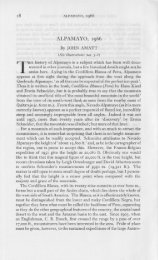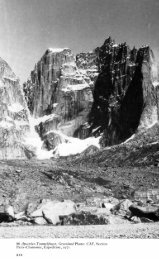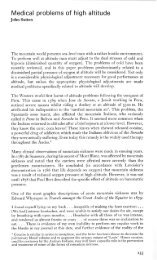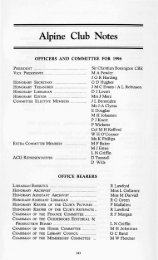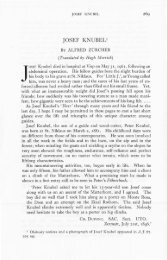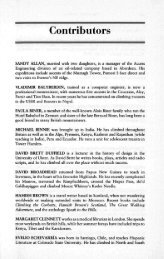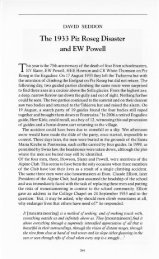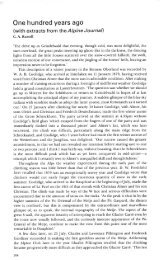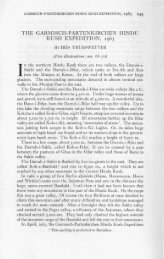AJ 2002 222-229 Ward Pundits.pdf - Alpine Journal
AJ 2002 222-229 Ward Pundits.pdf - Alpine Journal
AJ 2002 222-229 Ward Pundits.pdf - Alpine Journal
Create successful ePaper yourself
Turn your PDF publications into a flip-book with our unique Google optimized e-Paper software.
THE PUNDITS AND THE PAMIR<br />
The observations to be made by such natives should be as simple<br />
as possible. The instrumental equipment should be compact.<br />
I should propose the following as the primary objects of their<br />
explorations; 1st, the latitude of important points; 2nd, the heights<br />
of ditto; and 3rd, a rough survey from point to point; 4th, an account<br />
ofeach march and ofeach remarkable place visited.<br />
From the conjoint observations of the compass and watch, for<br />
the direction and the time occupied on each march, I should hope<br />
that we would also get a fair approximation to the longitude of the<br />
various places.<br />
I think the following instruments would be sufficient, viz.:<br />
One small sextant and artificial horizon.<br />
Two small thermometers to record the temperature of air and<br />
of boiling water.<br />
Two good silver watches, etc.<br />
The above skilfully used and the results honestly recorded, would<br />
at any rate give us an intelligible idea as to the whole of Eastern<br />
Turkistan.<br />
At present we are in great doubt as to what really is the position<br />
of the various cities and places in that portion of Central Asia.<br />
After Eastern Turkistan, I should recommend exploration to the<br />
east of the Pangkong Lake district, then in the Lassa direction and<br />
so on; but in each case I should recommend the explorers to<br />
accompany menwho have been in the habit of visiting the countries<br />
in question.<br />
Initially Montgomerie chose three men - the Mirza, the Havildar and the<br />
Mullah - to explore the largely unknown area beyond the Northwest<br />
Frontier and into Turkestan. About the size of France, it contained a plethora<br />
ofranges and isolated valleys where populations lived whose loyalties shifted<br />
yearly, and who acted as a buffer between the two empires.<br />
Although Chinese Buddhist pilgrims had crossed the Pamir in the 4th<br />
and 7th centuries and a Jesuit, Benedict de Goes, travelled from Peshawar<br />
to Kabul in 1602-3, it was to be another 200 years before John Wood reached<br />
the Wakhan corridor in 1838 and explored the Upper Oxus river. In 1860<br />
the Indian traveller Abdul Mejid crossed the Pamir from south to north<br />
and in 1865 the Pundit Munphool, in disguise and with three companions,<br />
visited Badakshan, butneitherwere trained surveyors. Ofthe Pamir, situated<br />
at the junction of the Russian, Chinese and British Empires, and therefore<br />
important politically and topographically, there was little solid information.<br />
The Pamir, or 'Roof of the World' according to the Arabs, are a central<br />
group of peaks linking the Hindu Kush, Western Kun Lun, Karakoram<br />
and Western Himalaya. They separate Tibet from Turkestan and from India.<br />
They consist of mainly rounded peaks and broad treeless valleys, and have<br />
223


